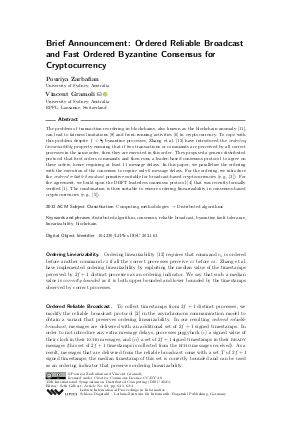Brief Announcement: Ordered Reliable Broadcast and Fast Ordered Byzantine Consensus for Cryptocurrency
Authors
Pouriya Zarbafian,
Vincent Gramoli 
-
Part of:
Volume:
35th International Symposium on Distributed Computing (DISC 2021)
Part of: Series: Leibniz International Proceedings in Informatics (LIPIcs)
Part of: Conference: International Symposium on Distributed Computing (DISC) - License:
 Creative Commons Attribution 4.0 International license
Creative Commons Attribution 4.0 International license
- Publication Date: 2021-10-04
File

PDF
LIPIcs.DISC.2021.63.pdf
- Filesize: 0.63 MB
- 4 pages
Document Identifiers
Subject Classification
ACM Subject Classification
- Computing methodologies → Distributed algorithms
Keywords
- distributed algorithm
- consensus
- reliable broadcast
- byzantine fault tolerance
- linearizability
- blockchain
Metrics
- Access Statistics
-
Total Accesses (updated on a weekly basis)
0Document
0Metadata
Abstract
The problem of transaction reordering in blockchains, also known as the blockchain anomaly [Christopher Natoli and Vincent Gramoli, 2016], can lead to fairness limitations [Kelkar et al., 2020] and front-running activities [Philip Daian et al., 2020] in cryptocurrency. To cope with this problem despite f < n/3 byzantine processes, Zhang et al. [Zhang et al., 2020] have introduced the ordering linearizability property ensuring that if two transactions or commands are perceived by all correct processes in the same order, then they are executed in this order. They proposed a generic distributed protocol that first orders commands and then runs a leader-based consensus protocol to agree on these orders, hence requiring at least 11 message delays. In this paper, we parallelize the ordering with the execution of the consensus to require only 6 message delays. For the ordering, we introduce the ordered reliable broadcast primitive suitable for broadcast-based cryptocurrencies (e.g., [Daniel Collins et al., 2020]). For the agreement, we build upon the DBFT leaderless consensus protocol [Tyler Crain et al., 2018] that was recently formally verified [Bertrand et al., 2021]. The combination is thus suitable to ensure ordering linearizability in consensus-based cryptocurrencies (e.g., [Tyler Crain et al., 2021]).
Cite As Get BibTex
Pouriya Zarbafian and Vincent Gramoli. Brief Announcement: Ordered Reliable Broadcast and Fast Ordered Byzantine Consensus for Cryptocurrency. In 35th International Symposium on Distributed Computing (DISC 2021). Leibniz International Proceedings in Informatics (LIPIcs), Volume 209, pp. 63:1-63:4, Schloss Dagstuhl – Leibniz-Zentrum für Informatik (2021)
https://doi.org/10.4230/LIPIcs.DISC.2021.63
BibTex
@InProceedings{zarbafian_et_al:LIPIcs.DISC.2021.63,
author = {Zarbafian, Pouriya and Gramoli, Vincent},
title = {{Brief Announcement: Ordered Reliable Broadcast and Fast Ordered Byzantine Consensus for Cryptocurrency}},
booktitle = {35th International Symposium on Distributed Computing (DISC 2021)},
pages = {63:1--63:4},
series = {Leibniz International Proceedings in Informatics (LIPIcs)},
ISBN = {978-3-95977-210-5},
ISSN = {1868-8969},
year = {2021},
volume = {209},
editor = {Gilbert, Seth},
publisher = {Schloss Dagstuhl -- Leibniz-Zentrum f{\"u}r Informatik},
address = {Dagstuhl, Germany},
URL = {https://drops.dagstuhl.de/entities/document/10.4230/LIPIcs.DISC.2021.63},
URN = {urn:nbn:de:0030-drops-148655},
doi = {10.4230/LIPIcs.DISC.2021.63},
annote = {Keywords: distributed algorithm, consensus, reliable broadcast, byzantine fault tolerance, linearizability, blockchain}
}
Author Details
References
- Nathalie Bertrand, Vincent Gramoli, Igor Konnov, Marijana Lazic, Pierre Tholoniat, and Josef Widder. Compositional Verification of Byzantine Consensus. Technical Report hal-03158911, HAL, March 2021. URL: https://hal.archives-ouvertes.fr/hal-03158911/file/paper.pdf.
-
Gabriel Bracha. Asynchronous Byzantine agreement protocols. Information and Computation, 75(2):130-143, 1987.

-
Daniel Collins, Rachid Guerraoui, Jovan Komatovic, Petr Kuznetsov, Matteo Monti, Matej Pavlovic, Yvonne-Anne Pignolet, Dragos-Adrian Seredinschi, Andrei Tonkikh, and Athanasios Xygkis. Online payments by merely broadcasting messages. In Proceedings of the 50th Annual IEEE/IFIP International Conference on Dependable Systems and Networks (DSN), pages 26-38, 2020.

-
Tyler Crain, Vincent Gramoli, Mikel Larrea, and Michel Raynal. DBFT: Efficient leaderless Byzantine consensus and its applications to blockchains. In Proceedings of the IEEE 17th International Symposium on Network Computing and Applications (NCA), pages 1-8, 2018.

-
Tyler Crain, Christopher Natoli, and Vincent Gramoli. Red Belly: A secure, fair and scalable open blockchain. In Proceedings of the 42nd IEEE Symposium on Security and Privacy (S&P), pages 466-483, 2021.

-
Philip Daian, Steven Goldfeder, Tyler Kell, Yunqi Li, Xueyuan Zhao, Iddo Bentov, Lorenz Breidenbach, and Ari Juels. Flash boys 2.0: Frontrunning in decentralized exchanges, miner extractable value, and consensus instability. In Proceedings of the 2020 IEEE Symposium on Security and Privacy (S&P), pages 910-927, 2020.

-
Cynthia Dwork, Nancy Lynch, and Larry Stockmeyer. Consensus in the presence of partial synchrony. J. ACM, 35(2):pp.288-323, 1988.

-
Mahimna Kelkar, Fan Zhang, Steven Goldfeder, and Ari Juels. Order-fairness for Byzantine consensus. In Annual International Cryptology Conference (CRYPTO), pages 451-480, 2020.

-
Klaus Kursawe. Wendy, the good little fairness widget: Achieving order fairness for blockchains. In Proceedings of the 2nd ACM Conference on Advances in Financial Technologies (AFT), pages 25-36, 2020.

- Satoshi Nakamoto. Bitcoin: A peer-to-peer electronic cash system, 2008. URL: https://bitcoin.org/bitcoin.pdf.
-
Christopher Natoli and Vincent Gramoli. The blockchain anomaly. In Proceedings of the 15th IEEE International Symposium on Network Computing and Applications (NCA), pages 310-317, 2016.

-
Yunhao Zhang, Srinath Setty, Qi Chen, Lidong Zhou, and Lorenzo Alvisi. Byzantine ordered consensus without Byzantine oligarchy. In 14th USENIX Symposium on Operating Systems Design and Implementation (OSDI), pages 633-649, 2020.

